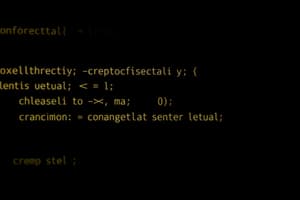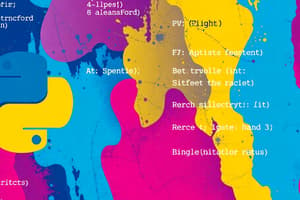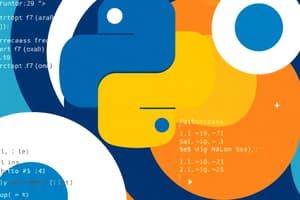Podcast
Questions and Answers
What is the primary purpose of functions in a program?
What is the primary purpose of functions in a program?
- To execute code in a linear fashion
- To eliminate the need for debugging
- To group statements performing a specific task (correct)
- To complicate the program structure
Which of the following is NOT a benefit of using functions in a program?
Which of the following is NOT a benefit of using functions in a program?
- Code reuse
- More code complexity (correct)
- Better testing and debugging
- Simpler code
What distinguishes a value-returning function from a void function?
What distinguishes a value-returning function from a void function?
- It does not execute any statements
- It requires multiple parameters
- It can only accept integer inputs
- It returns a value back to the caller (correct)
How do functions facilitate teamwork in programming?
How do functions facilitate teamwork in programming?
What is a void function primarily designed to do?
What is a void function primarily designed to do?
What is the primary purpose of the main function in a program?
What is the primary purpose of the main function in a program?
What is the proper way to handle indentation in Python?
What is the proper way to handle indentation in Python?
Which symbol is used in flowcharts to represent a function call?
Which symbol is used in flowcharts to represent a function call?
What does a hierarchy chart illustrate in program design?
What does a hierarchy chart illustrate in program design?
What is the effect of using the pass keyword in Python?
What is the effect of using the pass keyword in Python?
What best describes a local variable?
What best describes a local variable?
How does the use of blank lines within a code block affect its execution in Python?
How does the use of blank lines within a code block affect its execution in Python?
What is a common technique for breaking an algorithm into manageable sections?
What is a common technique for breaking an algorithm into manageable sections?
What does returning None from a function typically indicate?
What does returning None from a function typically indicate?
Which function from the math module would you use to obtain the square root of a number?
Which function from the math module would you use to obtain the square root of a number?
What is the primary purpose of the math module in Python?
What is the primary purpose of the math module in Python?
Which function would you use to convert an angle from degrees to radians in the math module?
Which function would you use to convert an angle from degrees to radians in the math module?
What will the divide function return if num2 equals 0?
What will the divide function return if num2 equals 0?
What is the purpose of the line 'if name == "main":' in a Python script?
What is the purpose of the line 'if name == "main":' in a Python script?
Which function is executed when the file first_module.py is run directly?
Which function is executed when the file first_module.py is run directly?
In the context of modular programming, what happens if you omit 'if name == "main":' in second_module.py?
In the context of modular programming, what happens if you omit 'if name == "main":' in second_module.py?
What benefit does modularizing code with functions provide, specifically in turtle graphics?
What benefit does modularizing code with functions provide, specifically in turtle graphics?
Which statement about the greet() function in first_module.py is true?
Which statement about the greet() function in first_module.py is true?
What does it mean for a variable to be local to a function?
What does it mean for a variable to be local to a function?
In the context of functions, what is the difference between an argument and a parameter?
In the context of functions, what is the difference between an argument and a parameter?
Why does the statement in the main function result in an error when trying to access the name variable created in get_name?
Why does the statement in the main function result in an error when trying to access the name variable created in get_name?
How is a function that accepts multiple arguments defined in Python?
How is a function that accepts multiple arguments defined in Python?
What is a key characteristic of local variables in different functions that share the same name?
What is a key characteristic of local variables in different functions that share the same name?
What is the purpose of using parentheses when calling a function?
What is the purpose of using parentheses when calling a function?
Which statement about parameters and their scope is true?
Which statement about parameters and their scope is true?
What happens if a variable is defined before its creation within a function?
What happens if a variable is defined before its creation within a function?
What is a global variable?
What is a global variable?
Why should global variables be avoided?
Why should global variables be avoided?
How can a global variable be declared within a function?
How can a global variable be declared within a function?
What is a global constant?
What is a global constant?
What is the purpose of the random module in Python?
What is the purpose of the random module in Python?
What does the 'randint' function do?
What does the 'randint' function do?
Which function allows you to specify a range for generating random floats?
Which function allows you to specify a range for generating random floats?
What is the purpose of the 'seed' function in random number generation?
What is the purpose of the 'seed' function in random number generation?
How is a value-returning function characterized?
How is a value-returning function characterized?
What should you include in a function to return a specified value?
What should you include in a function to return a specified value?
What happens if a variable is assigned a value inside a function without declaring it as global?
What happens if a variable is assigned a value inside a function without declaring it as global?
What function would you use to import functions from a module in Python?
What function would you use to import functions from a module in Python?
Which of the following is NOT a characteristic of void functions?
Which of the following is NOT a characteristic of void functions?
Flashcards
Function in Python
Function in Python
A group of statements that perform a specific task within a program.
Modular Program
Modular Program
A program where each task is in its own function.
Void Function
Void Function
Executes code then ends, doesn't return a value.
Value-Returning Function
Value-Returning Function
Signup and view all the flashcards
Benefits of Functions
Benefits of Functions
Signup and view all the flashcards
What is the purpose of the main function?
What is the purpose of the main function?
Signup and view all the flashcards
Why is indentation important in Python?
Why is indentation important in Python?
Signup and view all the flashcards
What is a flowchart?
What is a flowchart?
Signup and view all the flashcards
What is a hierarchy chart?
What is a hierarchy chart?
Signup and view all the flashcards
What is a local variable?
What is a local variable?
Signup and view all the flashcards
Can functions be empty?
Can functions be empty?
Signup and view all the flashcards
What does the input() function do?
What does the input() function do?
Signup and view all the flashcards
Why use separate flowcharts for each function?
Why use separate flowcharts for each function?
Signup and view all the flashcards
Local Variable
Local Variable
Signup and view all the flashcards
Scope of a Variable
Scope of a Variable
Signup and view all the flashcards
Argument
Argument
Signup and view all the flashcards
Parameter
Parameter
Signup and view all the flashcards
What does a parameter do?
What does a parameter do?
Signup and view all the flashcards
When are arguments passed?
When are arguments passed?
Signup and view all the flashcards
Parameter Scope
Parameter Scope
Signup and view all the flashcards
Passing Multiple Arguments
Passing Multiple Arguments
Signup and view all the flashcards
What does 'None' represent?
What does 'None' represent?
Signup and view all the flashcards
Why use 'None'?
Why use 'None'?
Signup and view all the flashcards
What is the math module?
What is the math module?
Signup and view all the flashcards
Import 'math'
Import 'math'
Signup and view all the flashcards
What is 'radians'?
What is 'radians'?
Signup and view all the flashcards
Global Variable Scope
Global Variable Scope
Signup and view all the flashcards
Modifying Global Variables
Modifying Global Variables
Signup and view all the flashcards
Global Constant
Global Constant
Signup and view all the flashcards
Simulating Global Constants
Simulating Global Constants
Signup and view all the flashcards
Function Type: Void
Function Type: Void
Signup and view all the flashcards
Function Type: Value-Returning
Function Type: Value-Returning
Signup and view all the flashcards
Standard Library
Standard Library
Signup and view all the flashcards
Modules for Standard Library
Modules for Standard Library
Signup and view all the flashcards
Calling a Function from a Module
Calling a Function from a Module
Signup and view all the flashcards
Random Number Generation
Random Number Generation
Signup and view all the flashcards
Random Module
Random Module
Signup and view all the flashcards
Dot Notation for Functions
Dot Notation for Functions
Signup and view all the flashcards
Seed Value for Random Numbers
Seed Value for Random Numbers
Signup and view all the flashcards
Writing Your Own Value-Returning Function
Writing Your Own Value-Returning Function
Signup and view all the flashcards
Conditional Execution of Main
Conditional Execution of Main
Signup and view all the flashcards
What is the purpose of if __name__ == '__main__':?
What is the purpose of if __name__ == '__main__':?
Signup and view all the flashcards
Why use conditional execution in modules?
Why use conditional execution in modules?
Signup and view all the flashcards
What is the difference between running and importing a file?
What is the difference between running and importing a file?
Signup and view all the flashcards
How does __name__ determine execution?
How does __name__ determine execution?
Signup and view all the flashcards
Study Notes
Introduction to Functions
- Function: group of statements performing a specific task
- Functions are for modularizing large programs
- Divided into smaller, manageable tasks
- Using functions improves organization, code reuse, and debugging
- The divide-and-conquer approach using functions
Void Functions and Value-Returning Functions
- Void function: executes statements and terminates.
- Value-returning function: executes statements, returns a value. Examples include
input(),int(),float().
Defining and Calling a Void Function
- Functions are named following specific naming rules:
- Cannot use keywords as a function name.
- Cannot contain spaces.
- The first character must be a letter or underscore.
- All other characters must be a letter, number, or underscore.
- Uppercase and lowercase characters are distinct.
- Function name should be descriptive of its task. Examples include
calculate_gross_pay(). - Function definition: specifies what the function does.
- Function header: first line of a function
def function_name():. - Block: set of statements that belong together (within a function).
- Executing a function: Function definitions don't execute—you need to call them.
- When a function is called: Interpreter jumps to the function, executes the block of statements, and resumes execution at the point that called the function (known as function return).
Example of Defining and Calling a Function
message()function defines a function containing print statements.- The code includes a call to message() to execute the function.
Defining and Calling a Void Function (cont.)
- Main Function:
- Called when a program starts.
- Calls other functions when needed.
- The main logic of the program.
Benefits of Modularizing a Program with Functions
- Simplifies code.
- Enables code reuse.
- Improves testing and debugging.
- Increases the speed of development.
- Facilitates teamwork. Different developers can work on different functions.
Indentation in Python
- Indentation is fundamental in Python for grouping statements.
- Proper indentation structures the Python code.
- Use spaces or tabs for indentation, not both, as this can be confusing.
Designing a Program to Use Functions
- Flowchart representation: function calls are shown as rectangles with vertical bars.
- Top-down design technique for breaking down algorithms into functions.
- Hierarchy chart is used to depict relationship between functions and functions called by other functions.
Local Variables
- Local variable: a variable assigned a value inside a function.
- Belongs to the function that created it.
- Accessible only inside that function.
Passing Arguments to Functions
- Argument: the data passed to a function when called.
- Parameter: a variable that receives an argument.
- Arguments are passed by position. The first argument is assigned to the first parameter, and so on.
- Scope of a parameter: the function in which the parameter is used.
Passing Multiple Arguments
- Python allows defining functions to use multiple arguments.
- Multiple arguments are passed to the function within the parentheses separated by commas. The order of the arguments matters; they're assigned to the parameters according to the position and order that they are provided.
Keyword Arguments
- Keyword arguments allow specifying which parameter the argument is assigned to.
- Order within the function call is irrelevant as long as the required parameter value is included.
Global Variables
- Global variables: Created by assignment statements outside all functions.
- Accessible from any statement in the program.
- To change a global variable, you must use
globalkeyword within a function.
Global Constants
- Global constants: global names referring to unchanging values.
- Use
globalkeyword to simulate constants in Python.
Introduction to Value-Returning Functions: Generating Random Numbers
- Value-returning functions return a value to the part of the program that called it.
randommodule: contains functions that generate random numbers.
Standard Library Functions and the import Statement
- Standard library: collection of pre-written functions;
print(),input(),range(). - Functions are often treated as "black boxes."
importstatement makes a library available for use.
Writing Your Own Value-Returning Functions
- Define a function.
- Give it parameters.
- Use a return statement.
- The function returns a value. You can assign the return value to a variable or use it in an expression.
Using IPO Charts
- IPO chart: Tool for describing function inputs, processing, and outputs.
- Columns are typically used to display the Input, Process, and Output.
Returning Strings
- Functions can return string values, containing text, characters, or words.
Returning Boolean Values
- Boolean functions return either
TrueorFalse. - Boolean values are used in decision and repetition structures.
- They simplify input validation, performing even checks, and more.
Returning Multiple Values
- Functions can return multiple values separated by a comma.
- Multiple variables are needed on the left side of the
=operator to capture the returned values.
Returning None From a Function
- None signifies the absence of a value.
- Returning
Noneis used to indicate errors in functions.
The math Module
- Provides mathematical functions.
- Imports
mathmodule (e.g.,import math). mathmodule libraries provide functions (math.sqrt(),math.pi,math.e).
Storing Functions in Modules
- Modules organize groups of related functions.
- Modules are important in organized, larger Python projects.
- Python code stored within a file with a
.pyextension can be accessed via animportstatement. - Modules can be accessed with
module.function()syntax.
Menu Driven Programs
- Menu Driven programs present a list of operations to the user.
- A menu is used for displaying the list of operations.
- Uses decision structures to determine the option from the menu. Repetitive until user selects quit.
Conditionally Executing the main Function
- Main function execution is restricted by including code within
if __name__=='__main__':. - Python’s built-in
__name__variable is set to__main__when the file is run directly.
Turtle Graphics
- Turtle graphics package for drawing shapes on the screen.
- Functions help in modularizing the drawing of standard shapes (squares, circles, lines, etc.) within a program.
Studying That Suits You
Use AI to generate personalized quizzes and flashcards to suit your learning preferences.




